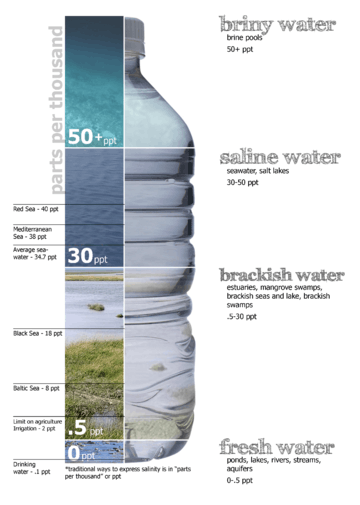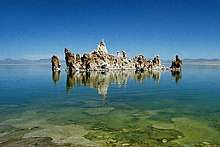Salt lake
A salt lake or saline lake is a landlocked body of water that has a concentration of salts (typically sodium chloride) and other dissolved minerals significantly higher than most lakes (often defined as at least three grams of salt per litre). In some cases, salt lakes have a higher concentration of salt than sea water; such lakes can also be termed hypersaline lakes. An alkalic salt lake that has a high content of carbonate is sometimes termed a soda lake.
| Part of a series on |
| Water salinity |
|---|
 |
| Salinity levels |
|
Fresh water (< 0.05%) Brackish water (0.05–3%) Saline water (3–5%) Brine (> 5% up to 26%-28% max) |
| Bodies of water |
One saline lake classification differentiates between:
- subsaline: 0.5–3‰ (0.05-0.3%)
- hyposaline: 3–20‰ (0.3-2%)
- mesosaline: 20–50‰ (2-5%)
- hypersaline: greater than 50‰ (5%)[1]
Properties
Salt lakes form when the water flowing into the lake, containing salt or minerals, cannot leave because the lake is endorheic (terminal). The water then evaporates, leaving behind any dissolved salts and thus increasing its salinity, making a salt lake an excellent place for salt production. High salinity will also lead to a unique halophilic flora and fauna in the lake in question; sometimes, in fact, the result may be an absence or near absence of life near the salt lake.
If the amount of water flowing into a lake is less than the amount evaporated, the lake will eventually disappear and leave a dry lake (also called playa or salt flat).
Brine lakes consist of water that has reached salt saturation or near saturation (brine), and may also be heavily saturated with other materials.
Most brine lakes develop as a result of high evaporation rates in an arid climate with a lack of an outlet to the ocean. The high salt content in these bodies of water may come from minerals deposited from the surrounding land. Another source for the salt may be that the body of water was formerly connected to the ocean. While the water evaporates from the lake, the salt remains. Eventually, the body of water will become brine.
Because of the density of brine, swimmers are more buoyant in brine than in fresh or ordinary salt water. Examples of such brine lakes are the Dead Sea and the Great Salt Lake.
Bodies of brine may also form on the ocean floor at cold seeps. These are sometimes called brine lakes, but are more frequently referred to as brine pools. It is possible to observe waves on the surface of these bodies.[2]
Man-made bodies of brine are created for edible salt production. These can be referred to as brine ponds.
List


_in_Ethiopia.jpg)
- Aral Sea
- Aydar Lake
- Bakhtegan Lake
- Caspian Sea
- Chott el Djerid
- Dead Sea
- Devil's Lake
- Don Juan Pond
- Great Salt Lake
- Laguna Colorada
- Laguna Verde
- Lake Assal
- Lake Bumbunga
- Lake Elton
- Lake Eyre
- Lake Gairdner
- Lake Hillier
- Lake Karum
- Lake Mackay
- Lake Natron
- Lake Paliastomi
- Lake Texoma
- Lake Torrens
- Lake Tuz
- Lake Tyrrell
- Lake Urmia
- Lake Van
- Lake Vanda
- Little Manitou Lake
- Loch Hyne
- Maharloo Lake
- Mar Chiquita Lake
- Mono Lake
- Nam Lake
- Redberry Lake
- Salton Sea
- Sambhar Salt Lake
- Sarygamysh Lake
- Sawa Lake
- Sutton Salt Lake
- Lonar Lake
- Lake Abert
- Lake Balkhash
- Dabusun Lake
- Siling Lake
- Pulicat Lake
- Lake Pontchartrain
- Uvs Lake
- Lake Barlee
- Chilika Lake
- South Hulsan Lake
- Lake Alakol
- Pangong Lake
- Lake Baskunchak
- Qarhan Playa
- Palm Tree Lagoon
- Black Throat Lake
- Lake Crosbie
- Larnaca Salt Lake
Some of the last 18 salt lakes in this list are also partly fresh and/or brackish water. Like a body of water can have "sea" in its name and technically be a salt lake (for instance, the Salton Sea really being a salt lake), some of the last 18 listed salt lakes are playas, basins or ponds. This might even be the same way for the original 32 salt lakes that were listed here until April 6, 2020. Civilization tends to loosely categorize many of earth's bodies of water.
117,000,000 lakes scatter the earth, and together they only hold about seventeen thousandths or less of all water on earth, making salt lakes more interesting and special.
See also
- Brine pool – large area of brine on the ocean basin
- Halocline – Stratification of a body of water due to salinity differences
- Halophile – organism that thrives in high salt concentrations
- Hypersaline lake – Landlocked body of water that contains concentrations of salts greater than the sea
- List of bodies of water by salinity
References
- Hammer, U. T. (1986). Saline Lake Ecosystems of the World. Springer. pp. 14–15. ISBN 90-6193-535-0. Retrieved 5 June 2020.
- "NOAA Ocean Explorer: Expedition to the Deep Slope: May 31 Log". www.oceanexplorer.noaa.gov. Retrieved 30 March 2018.
External links
![]()
